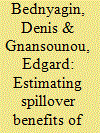|
|
|
Sort Order |
|
|
|
Items / Page
|
|
|
|
|
|
|
| Srl | Item |
| 1 |
ID:
111335


|
|
|
|
|
| Publication |
2012.
|
| Summary/Abstract |
This paper is focused on the analysis of spillover benefits of the ongoing R&D programme on thermonuclear fusion technology. The spillover effects are understood here as positive externalities of publicly funded R&D, demonstration and deployment (RDDD) activities that may be revealed at the companies' level in the form of newly created knowledge stock; development of innovative products/processes with broader market applications; strengthening of R&D, manufacturing and marketing capabilities; etc. An integrated compound real options model is proposed that allows to estimate the strategic net social present value of fusion RDDD programme taking into account the different types of spillover benefits along with the hidden real options value arising due to uncertainty and managerial flexibility. It was found that the value of spillover effects, modelled as "expansion option", could represent a significant proportion of the overall socio-economic value of fusion RDDD programme (nearly 20%). This paper clearly demonstrates that, besides a high-level mission to assure sustainable energy supply, fusion RDDD programme may yield substantial net socio-economic benefits that may be at least two times higher compared to the expected RD&D costs, and hence the pursuit of even more ambitious programme is economically justified.
|
|
|
|
|
|
|
|
|
|
|
|
|
|
|
|
| 2 |
ID:
052299


|
|
|
|
|
| Publication |
Oct 2004.
|
| Summary/Abstract |
In this paper, the opportunity for the inter-regional integration of the electricity market in East China is analysed on the basis of strategies for the future expansion of the electricity generation system. We assume that during its first stage, the operational breakthrough of the electricity sector reform in China will be to achieve an economic dispatch of the generating plants. On the basis of this assumed goal a multi-region model is proposed to appraise the potential benefits of an integrated inter-regional electricity market. This model includes: propositions on design and operation of the market, electricity demand forecasting, least-cost generating system expansion. As case study, three strategies of electricity supply are assessed in two provinces: Shandong and Shanghai in East China. While Shandong is a potential electricity exporter due to availability of primary energy resources, Shanghai is an electricity importer. The strategies include: autarkical expansion of each regional system, import/export only for minimizing operation costs, integration of the system expansion for minimizing total costs including operation and investment costs. One of the findings is that building up an inter-regional integrated electricity market is profitable for both the Shanghai and Shandong regions compared with the two other strategies, if the future regulation makes it possible to insure an economic dispatch of the generating power plants.
|
|
|
|
|
|
|
|
|
|
|
|
|
|
|
|
| 3 |
ID:
101382


|
|
|
|
|
| Publication |
2011.
|
| Summary/Abstract |
This paper aims to perform a real options valuation of fusion energy R&D programme. Strategic value of thermonuclear fusion technology is estimated here based on the expected cash flows from construction and operation of fusion power plants and the real options value arising due to managerial flexibility and the underlying uncertainty. First, a basic investment option model of Black-Scholes type is being considered. Then, a fuzzy compound real R&D option model is elaborated, which reflects in a better way the multi-stage nature of the programme and takes into account the imprecision of information as one of the components of the overall programme uncertainty. Two different strategies are compared: "Baseline" corresponding to a relatively moderate pace of fusion research, development, demonstration and deployment activities vs. "Accelerated" strategy, which assumes a rapid demonstration and massive deployment of fusion. The conclusions are drawn from the model calculations regarding the strategic value of fusion energy R&D and the advantages of accelerated development path.
|
|
|
|
|
|
|
|
|
|
|
|
|
|
|
|
| 4 |
ID:
096109


|
|
|
|
|
| Publication |
2010.
|
| Summary/Abstract |
The disturbances of energy supply that may result from both external and domestic events create a significant threat for national economy due to potential impacts on the productivity, employment and overall economic growth. Building scenarios of the economy's vulnerability to these disturbances is delicate because of the significant number of interrelated factors that should be taken into consideration. In this paper, a logic-based model (LBM) is developed, which allows for defining, exploring and assessing the determinants and the indicators of the economy's vulnerability related to the energy supply disturbances within a coherent scenarios assessment framework. The proposed model is illustrated with the case of China. After developing the general framework, three particular scenarios are investigated. Based on the case study, the performance and limitations of the model are analyzed, and its ability to evaluate national energy policies is discussed. Finally, some recommendations for further improvements are made.
|
|
|
|
|
|
|
|
|
|
|
|
|
|
|
|
|
|
|
|
|